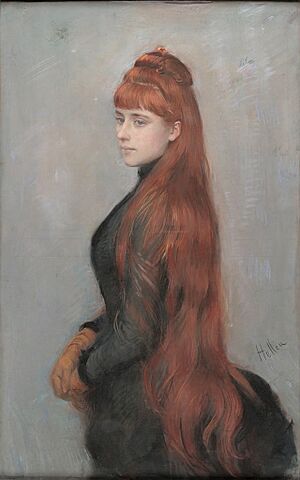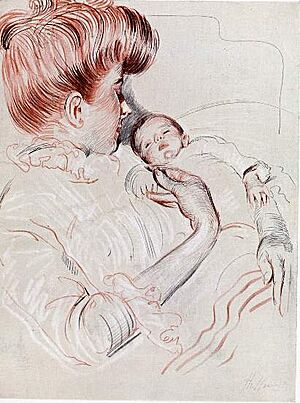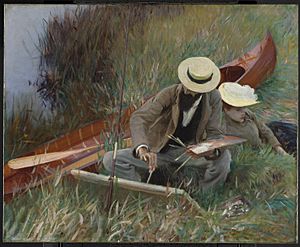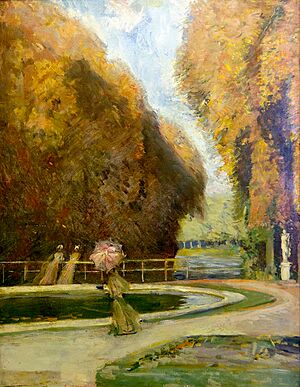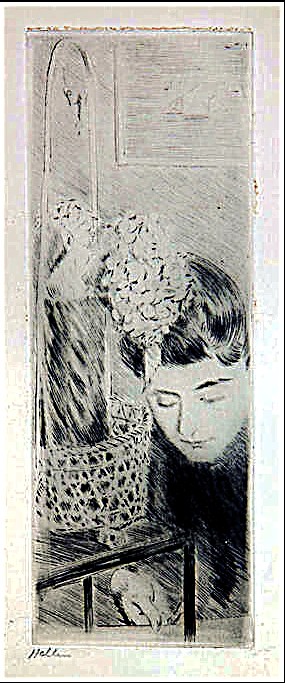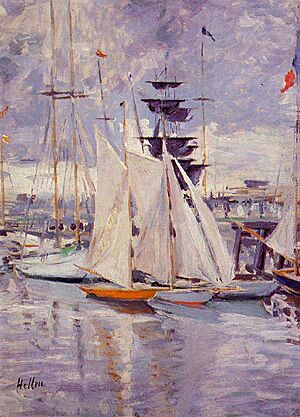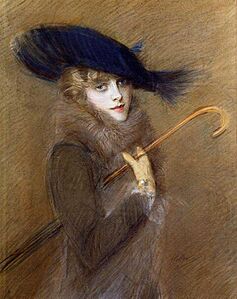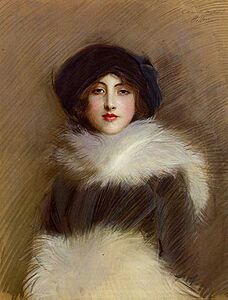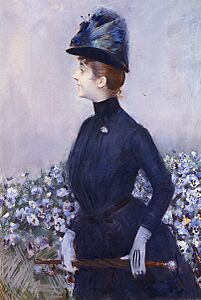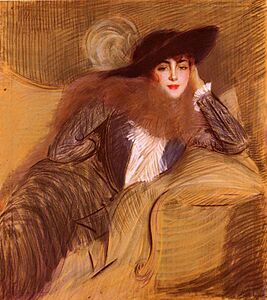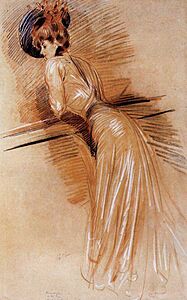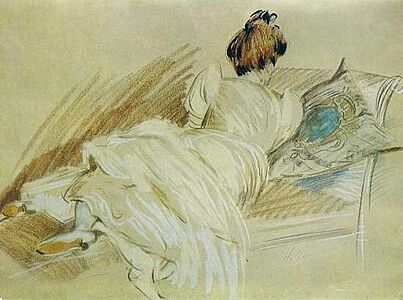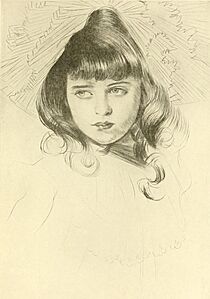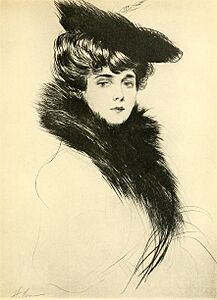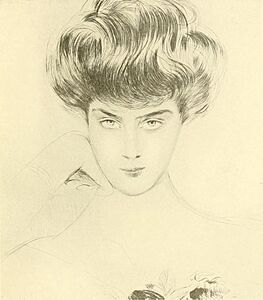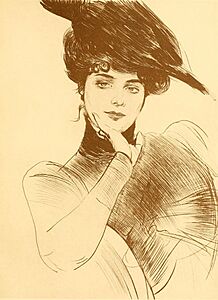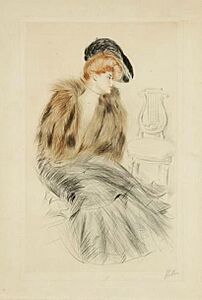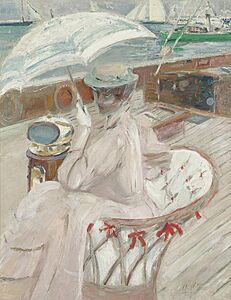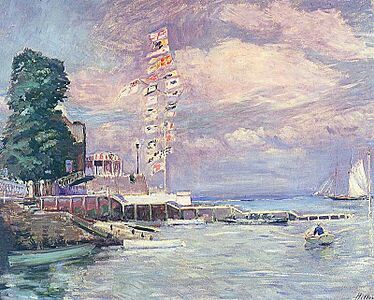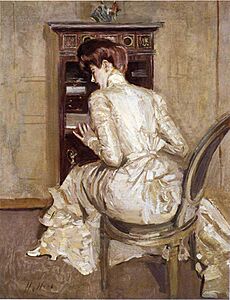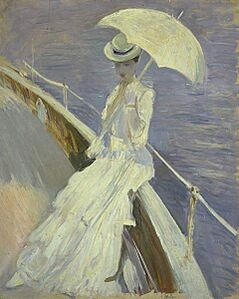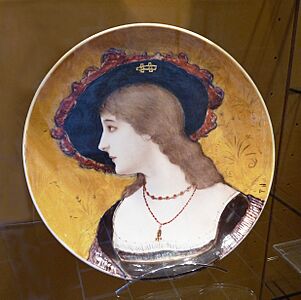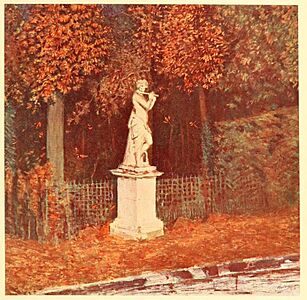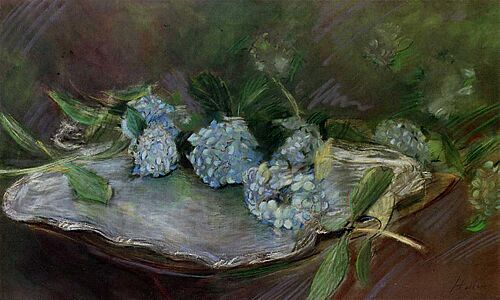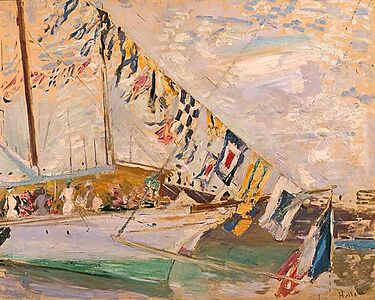Paul César Helleu facts for kids
Quick facts for kids
Paul César Helleu
|
|
|---|---|
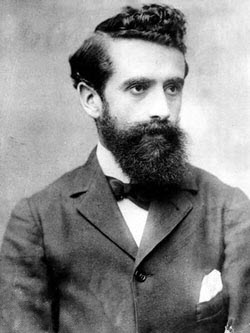
Helleu, c. 1880s
|
|
| Born | 17 December 1859 |
| Died | 23 March 1927 (aged 67) Paris, France
|
| Nationality | French |
| Education | École des Beaux-Arts |
| Known for | etcher, painter |
|
Notable work
|
Portrait d’Alice Guérin Grand Central Terminal ceiling |
| Movement | Post-Impressionism |
| Awards | Légion d'honneur (1904) |
Paul César Helleu (born 1859, died 1927) was a French artist. He painted with oils and pastels. He was also a designer and made prints using a special technique called drypoint. Helleu was famous for painting portraits of elegant women. These women lived during a time called the Belle Époque. Helleu also designed the starry ceiling at Grand Central Terminal in New York City. His son and grandson later became artistic directors for Parfums Chanel.
Contents
Helleu's Early Life and Art Training
Paul César Helleu was born in Vannes, France. His father passed away when Helleu was a teenager. Even though his mother did not agree, he moved to Paris. There, he studied at Lycée Chaptal.
In 1876, when he was 16, Helleu joined the École des Beaux-Arts. This is a famous art school. He learned art from Jean-Léon Gérôme. That same year, Helleu saw the Second Impressionist Exhibition. He met famous artists like John Singer Sargent, James McNeill Whistler, and Claude Monet.
Helleu was amazed by their modern painting style. They painted quickly and often outdoors. This was very different from studio art. After art school, Helleu worked for a company. He hand-painted beautiful plates. During this time, he met Giovanni Boldini. Boldini was a portrait painter. He became Helleu's friend and teacher. Boldini greatly influenced Helleu's art style.
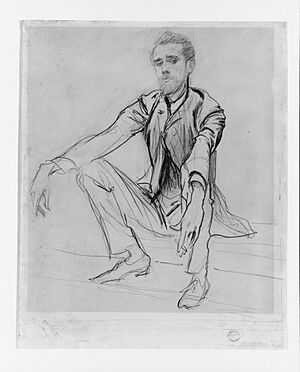
Friendships and Support
When Helleu was 18, he became close friends with John Singer Sargent. Sargent was four years older. Their friendship lasted their whole lives. Sargent was already a successful artist. Helleu had not sold any paintings. He felt very discouraged. He almost gave up his art studies.
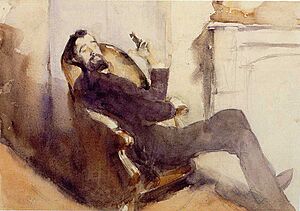
When Sargent heard this, he visited Helleu. He picked one of Helleu's paintings. Sargent praised Helleu's painting skills. Helleu was flattered. He offered to give the painting to Sargent. Sargent replied, "I will gladly take this, Helleu, but not as a gift. I sell my own pictures. I know what they cost me. I would not enjoy this painting if I didn't pay you a fair price." Then, Sargent paid him a thousand-franc note.
Marriage and New Art Techniques
In 1884, Helleu was asked to paint a portrait. It was of a young woman named Alice Guérin (1870–1933). They fell in love and married on July 28, 1886. Alice became his favorite model. She was charming and graceful. She helped them meet important people in Paris. They became very popular in high society.
In 1885, Helleu went to London. He met Whistler again. He also visited other artists. He met James Jacques Tissot. Tissot was a French painter who worked in England. Tissot showed Helleu a new way to make art. It was called drypoint etching. This technique uses a diamond point tool. You draw directly onto a copper plate.
Helleu quickly became very skilled at drypoint. He drew with the same freedom as with his pastels. His prints were very popular. People could get several copies for family or friends. Helleu made over 2,000 drypoint prints in his career.
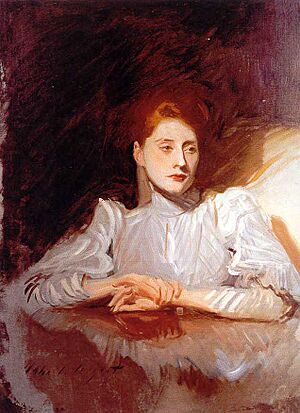
Art Exhibitions and Famous Friends
Soon, Helleu showed his art in many galleries. He received much praise. Degas encouraged him to show paintings. This was for the Eighth Impressionist Exhibition in 1886. The show was in a Paris apartment. It happened at the same time as the official Salon. This was to make a statement. Seventeen artists joined the show. It included the first Neo-Impressionistic works. But Helleu, like Monet, chose not to participate.
In 1886, Helleu became friends with Robert de Montesquiou. Montesquiou was a poet. He bought six of Helleu's drypoint prints. Montesquiou later wrote a book about Helleu. It was published in 1913. The book had pictures of 100 of Helleu's prints and drawings. This book is still the main biography of Helleu.
Montesquiou introduced Helleu to Paris literary groups. There, he met Marcel Proust, who also became his friend. Proust wrote about Helleu in his novel Remembrance of Things Past. Helleu was the painter Elstir in the book. (Later, Helleu made a famous portrait of Proust after he died.) Montesquiou's cousin, the Countess Greffulhe, helped Helleu. She helped him paint portraits of elegant women. These women were from the highest levels of Paris society. These portraits made him famous. His subjects included the Duchess of Marlborough and Helena Rubinstein.
New Subjects and Recognition
Helleu looked for new ideas. In 1893, he started painting cathedrals. He also painted stained glass windows. Then he painted flowers and landscapes of parks. These parks were in Versailles. Helleu also started sailing. He owned four yachts in his life. Ships, harbor views, and life at port became subjects for his art. Women in their stylish seaside clothes also appeared in his works.
In 1904, Helleu received the Légion d'honneur. This is a very important award in France. He became a celebrated artist in Paris and London. He was an honorary member of important art groups. These included the International Society of Painters, Sculptors, and Engravers. This group was led by Auguste Rodin. He was also part of the Société Nationale des Beaux-Arts.
Grand Central Terminal Ceiling
On his second trip to the United States in 1912, Helleu got a special job. He was asked to design the ceiling of Grand Central Terminal in New York City. He decided on a mural of a blue-green night sky. It was covered with the starry signs of the zodiac. These stars crossed the Milky Way.
People admired the design. However, the ceiling was covered in the 1930s. It was completely cleaned and fixed in 1998.

Later Life and Legacy
Helleu made his last trip to New York City in 1920. He had an exhibition of his work there. But he felt that the Belle Époque was over. He felt out of touch with the new times. Soon after returning to France, he destroyed almost all of his copper plates. He then retired to spend time with his family.
Helleu was planning a new exhibition. He was working with Jean-Louis Forain. But he died in 1927 at age 67. He passed away after surgery in Paris.
Coco Chanel was one of his many friends. She chose beige as her special color because of his advice. It was the color of the sand on the beach in Biarritz in the early morning. Both his son Jean Helleu and his grandson Jacques Helleu became artistic directors for Parfums Chanel.
Pastel Portraits
Prints
Oil Paintings
Miscellaneous Subjects


